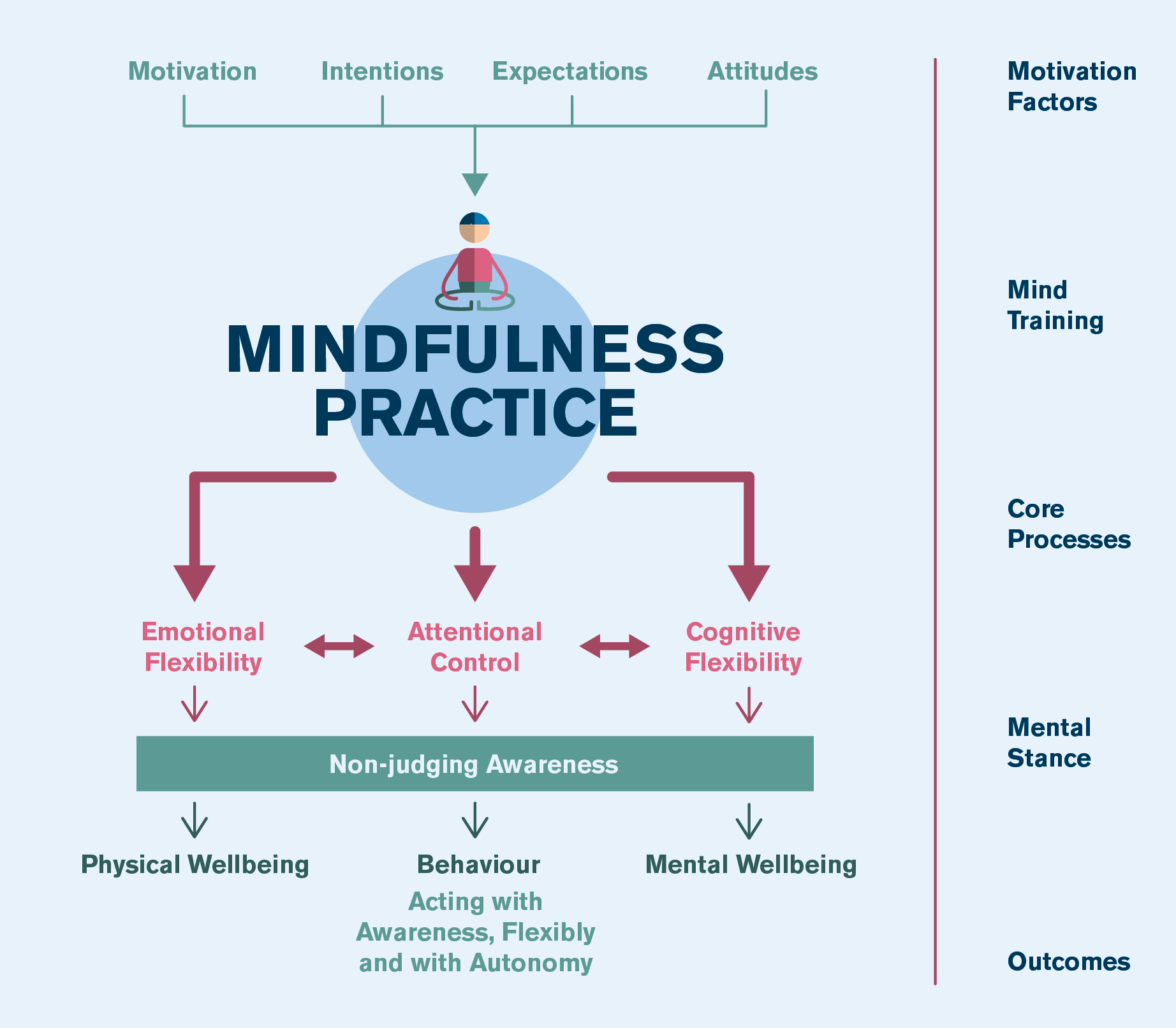Meditation and Art Therapy Wellness Benefits
PART 4 OF 4
Dr Russell Chan explains the similarities between meditation and art therapy, and why practising both enhances one’s mental health and overall wellbeing. He also shares some tips on how to cultivate a regular meditation practice
Over the last few blog articles (read part one, part two and part three), we looked at meditation, its application to art appreciation, and how it can improve our attention and creativity. These improvements in attention and creativity are the building blocks of positive changes in mental health, mood and psychological conditions such as post-traumatic stress disorders (PTSD)1. Art therapy has been increasingly shown to help with mental health and psychological issues too2. Art therapy is a form of psychotherapy that employs artistic creation for the purpose of understanding individual personality processes3. An art therapy session typically consists of an individual or group interacting with a therapist who supports self-expression through various artistic mediums such as visual art, music, dance, drama or writing. The process of artistic expression, accompanied by reflection and discussion provides a healing effect and can be effective in dealing with mental and physical pain, fatigue and anxiety4. Let us look at the similarities between meditation and art therapy and how they both improve our attention and creativity, leading to better mental and emotional health.
Art and Meditation Both Facilitate Self-Reflection
The process of self-reflection is a very daunting experience and we naturally avoid undertaking such mentally and emotionally challenging tasks. During the day, our mind usually zooms from one task to another without a chance for us to sit and reflect. And when we do reflect, we most likely have a biased view of different situations.
Many meditation practitioners report that one resulting effect of regular meditation practice is a sense of acceptance: an acceptance of past, present and future situations without reacting in judgement. Meditation allows us to see how our own actions have brought us to our current pain or happiness, much as if we are separate entities observing images of ourselves navigating situations. But the attitude with which we observe ourselves is not of blame or judgement; it is of acceptance. Acceptance opens us up to forgiveness (whether it is for ourselves or another person) and offers us a new blank slate to embrace moving forward.
This process is also evident in the creation of art, where reflexivity and acceptance are cultivated from moment to moment. Can we paint or draw without fear and accept that sometimes mistakes occur, or do we approach our work with criticism, anger and self-blame? Art, like meditation, creates distance between ourselves and negative, anxious thoughts; a reprieve from our usual selves caught up in a cloud of thoughts and emotions5. Therefore, creating art is about reaching a state of understanding that breaks free from the constant debilitating chatter of the mind and cultivating a sense of emotional flexibility. This means that while our emotions are felt readily, we would not be overwhelmed or react uncontrollably.
In the final Unwind with SAM: Art & Meditation session, we studied Dawn Ng’s Mamashop6, an artwork that comment on how what we seek outside is often close to or within ourselves. The art piece takes a nostalgic look at “mama shops”: ubiquitous shops operating at void decks of housing development blocks in Singapore, prompting an appreciation of the value in everyday vignettes that are often overlooked in modern society. It suggests that what we need is often not too far away from our doorstep and that the “grass is not always greener” on the flip side.

Dawn Ng. Mamashop. 2012. Archival inkjet print collage, 160 x 120 cm. Collection of Singapore Art Museum.
This theme becomes evident when we practice meditation. The results from self-reflection are often that it is not external events or the actions of others that we need to control; it is ourselves. Cultivation of the self is paramount.
Meditation and Art Both Enhance Flow
If you have ever coloured in one of those mindfulness colouring books, you might have noticed that time seems to stop when you become focused. Your focus might be so intent that in completing the entire piece you were unaware of the time that flew by. This is understood as a “flow-state” and is natural when we become absorbed in a certain task. Meditation and creating or appreciating art encourage this flow-state and cultivates a sense of wholeness within ourselves. The resulting effect is that we might experience the passage of time differently. Why is this important? Flow-state allows us to perform mental time-travel7 and alters how we might recall certain memories differently. We become conscious of how quickly or slowly we experience these memories and the emotions that arise from them.
Meditation and Art Are Both Stable Practices for Your Mind
Art and meditation are both practices that you can consistently fall back on because they are both considered learned skills. I remember on the fifth day of my first week-long meditation retreat about a decade ago, I experienced how I was able to become an observer of my own thoughts. This was a profound experience and one that is analogous to being an observer of your own art and the artist at the same time. This affected my perspective on the varied experiences of life. Throughout life’s ups and downs, I have been able to fall back onto my meditation practice time and time again like a trusted old friend – befriending my mind instead of fighting against it. Similarly, appreciating or creating art for me has become a skill that one can fall back on and offers a safe space to explore emotions and the inner workings of the mind.
Instead of always having to waver between extreme highs and lows, we can opt to practice both meditation and art as they help to nurture a mental space that provides stability and a constant connection to our true selves. Fluctuations are less extreme and there is an increased stability in the mind, which in turn leads to harmony with our physical surroundings and overall wellbeing.
The Effects of Meditation and Art, Summarised by the Liverpool Mindfulness Model
To end, I would like to draw upon the Liverpool Mindfulness Model (see Figure 1 below) to outline the effects of a regular mindfulness practice (i.e. both meditation and art). Although each of us might begin meditation with different intentions, expectations and motivations, a mindfulness practice helps us to first train attention as a central cognitive function. This attentional training leads to a further understanding of linked emotional (self-reflection) and cognitive flexibility (mental time-travel). Eventually, the improvements in behaviour result in a non-judgemental awareness of our own thought processes. Our future behaviour eventually changes for the better, and we may perform our actions autonomously with increased awareness and flexibility.

Figure 1. The Liverpool Mindfulness Model, adapted from Malinowski (2013)8.
It is clear that the effects of meditation and art both complement each other. You may ask which of them should you attempt first – the answer is any! The hardest step in this case is not the first that should be taken, but the regularity of practice. One may go away on a retreat and feel the intense and profound effects of meditation and feel that it helps with daily life. A single retreat may give you the motivation for a short period of time, but the key is to use the momentum to create a regular practice. This will ensure that you will continue to understand the nature of your own mind and gain the continuous and sustained benefits. Start with two or three times a week at a set time with as little as 15 minutes a day. It is just like going to the gym – if you can spare an hour to exercise the body, you can also do so for the mind. Find a teacher, a style or a lineage of meditation that you respect and resonates with you. I recommend not changing your practice too often and working it up slowly with regularity. Until next time, see you all on the mat!
This is the final part of a four-part article series on the science behind meditation and how to apply it to art. Please click to read part one, two and three.
About the author
Dr Russell Chan is a neuroscientist. He is fascinated by the mind and its potential for cognitive performance. Using different neuroimaging techniques, Chan investigates how meditation can impact our health, well-being and performance. He has been a yoga and meditation teacher for the last eight years and is the Director of www.primeyourmindnow.com, a website examining meditation, spirituality, cognitive neuroscience and motor control. Over the next few weeks, as you explore the unique style of Yoga Nidra meditation with him, he hopes that you will enjoy the journey and come to a deeper understanding of the science behind meditation.
_____
References:
1. Lang AJ, Strauss JL, Bomyea J, et al. The theoretical and empirical basis for meditation as an intervention for PTSD. Behavior modification. 2012;36(6):759-786
2 Attard A, Larkin M. Art therapy for people with psychosis: a narrative review of the literature. Lancet Psychiatry. 2016;3(11):1067-1078
3 Hacmun I, Regev D, Salomon R. The Principles of Art Therapy in Virtual Reality. Frontiers in psychology. 2018;9:2082
4 Case C, Dalley T. The Handbook of Art Therapy. Routledge; 2014
5 Gambis M. Why making art is the new meditation. The Washington Post. https://www.washingtonpost.com/news/inspired-life/wp/2015/08/25/why-making-art-is-the-new-meditation/. Published 2015. Accessed27/07/2020
6 RootsSG. Mamashop (Dawn Ng). RootsSG - https://www.roots.sg/learn/collections/listing/1321414
7 Corballis MC. Language, Memory, and Mental Time Travel: An Evolutionary Perspective. Frontiers in human neuroscience. 2019;13:217
8 Malinowski P. Neural mechanisms of attentional control in mindfulness meditation. Frontiers in neuroscience. 2013;7:8


